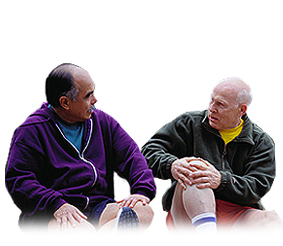American Academy of Orthopaedic Surgeons (AAOS). American Academy of Orthopaedic
Surgeons clinical practice guideline on treatment of osteoarthritis of the knee.
2nd ed. Rosemont (IL): American Academy of Orthopaedic Surgeons (AAOS); 2013 May
18.
Bannuru RR, Schmid CH, Kent DM, Vaysbrot EE, Wong JB, McAlindon TE. Comparative
effectiveness of pharmacologic interventions for knee osteoarthritis: a systematic
review and network meta-analysis. Ann Intern Med. 2015;162(1):46-54. PMID: 25560713
www.ncbi.nlm.nih.gov/pubmed/25560713.
Bennell KL, Buchbinder R, Hinman RS. Physical therapies in the management of osteoarthritis:
current state of the evidence. Curr Opin Rheumatol. 2015;27(3):304-311. PMID: 25775185
www.ncbi.nlm.nih.gov/pubmed/25775185.
Crenshaw AH. Soft tissue procedures and corrective osteotomies about the knee. In:
Azar FM, Beatty JH, Canale ST, eds. Campbell's Operative Orthopaedics. 13th ed.
Philadelphia, PA: Elsevier; 2017:chap 9.
Duivenvoorden T, Brouwer RW, van Raaij TM, Verhagen AP, Verhaar JA, Bierma-Zeinstra
SM. Braces and orthoses for treating osteoarthritis of the knee. Cochrane Database Syst Rev. 2015;3:CD004020. PMID: 25773267
www.ncbi.nlm.nih.gov/pubmed/25773267.
Fransen M, Agaliotis M, Nairn L, et al; LEGS study collaborative group. Glucosamine
and chondroitin for knee osteoarthritis: a double-blind randomized placebo-controlled
clinical trial evaluating single and combination regimens. AnnRheum Dis. 2015;74(5):851-8.
PMID: 24395557 www.ncbi.nlm.nih.gov/pubmed/24395557.
Groen VA, van de Graaf VA, Scholtes VA, Sprague S, van Wagensveld BA, Poolman RW.
Effects of bariatric surgery for knee complaints in (morbidly) obese adult patients:
a systematic review. Obes Rev. 2015;16(2):161-170. PMID: 25487972
www.ncbi.nlm.nih.gov/pubmed/25487972.
Hochberg MC, Altman RD, April KT, et al. American College of Rheumatology 2012 recommendations
for the use of nonpharmacologic and pharmacologic therapies in osteoarthritis of
the hand, hip, and knee. Arthritis Care Res (Hoboken). 2012;64(4):465-474. PMID:
22563589 www.ncbi.nlm.nih.gov/pubmed/22563589.
Lieberman JR, Engstrom SM, Solovyova O, Au C, Grady JJ. Is intra-articular hyaluronic
acid effective in treating osteoarthritis of the hip joint? J Arthroplasty. 2015;30(3):507-511.
PMID: 25542833 www.ncbi.nlm.nih.gov/pubmed/25542833.
Malagelada F, Vega J, Golano P, Beynnon B, Ertem F. Knee anatomy and biomechanics
of the knee. In: Miller MD, Thompson SR, eds. DeLee and Drez’s Orthopaedic Sports Medicine. 4th ed. Philadelphia, PA: Elsevier Saunders; 2015:chap 91.
Mascioli AA. Arthrodesis the knee. In: Azar FM, Beatty JH, Canale ST, eds. Campbell's Operative Orthopaedics. 13th ed. Philadelphia, PA: Elsevier; 2017:chap 8.
Mihalko WM. Arthroplasty of the knee. In: Azar FM, Beatty JH, Canale ST, eds.
Campbell's Operative Orthopaedics. 13th ed. Philadelphia, PA: Elsevier; 2017:chap 7.
Moyer RF, Birmingham TB, Bryant DM, Giffin JR, Marriott KA, Leitch KM. Valgus bracing
for knee osteoarthritis: a meta-analysis of randomized trials. Arthritis Care Res
(Hoboken). 2015;67(4):493-501. PMID: 25201520
www.ncbi.nlm.nih.gov/pubmed/25201520.
Paluska SA. Knee braces. In: Pfenninger JL, Fowler GC, eds.
Pfenninger and Fowler's
Procedures for Primary Care. 3rd ed. Philadelphia, PA: Elsevier Mosby; 2011:chap
193.
Percope de Andrade MA, Campos TV, Abreu-E-Silva GM. Supplementary methods in the
nonsurgical treatment of osteoarthritis. Arthroscopy. 2015;31(4):785-792. PMID:
25633815 www.ncbi.nlm.nih.gov/pubmed/25633815.
Silverwood V, Blagojevic-Bucknall M, Jinks C, Jordan JL, Protheroe J, Jordan KP.
Current evidence on risk factors for knee osteoarthritis in older adults: a systematic
review and meta-analysis. Osteoarthritis Cartilage. 2015;23(4):507-515. PMID: 25447976
www.ncbi.nlm.nih.gov/pubmed/25447976.
The information provided herein should not be used during any medical emergency or for the diagnosis or treatment of any medical condition. A licensed medical professional should be consulted for diagnosis and treatment of any and all medical conditions. Links to other sites are provided for information only -- they do not constitute endorsements of those other sites. No warranty of any kind, either expressed or implied, is made as to the accuracy, reliability, timeliness, or correctness of any translations made by a third-party service of the information provided herein into any other language. © 1997-
A.D.A.M., a business unit of Ebix, Inc. Any duplication or distribution of the information contained herein is strictly prohibited.













